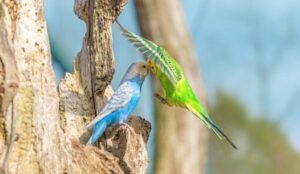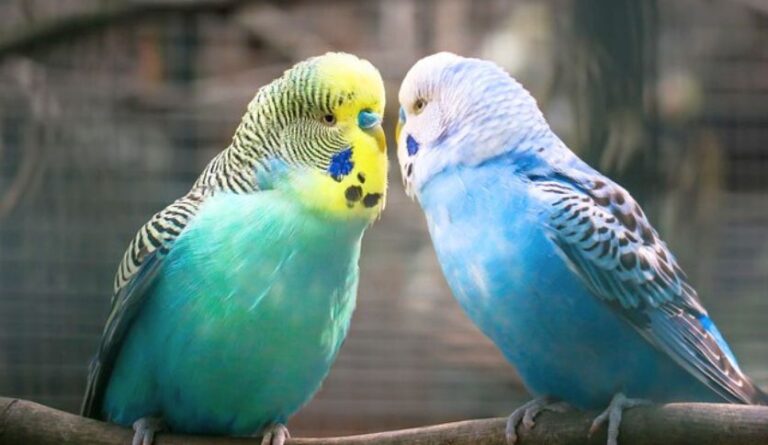Parakeets, with their vibrant colors and lively personalities, have won the hearts of many as delightful companions. As a parakeet parent, one of your top priorities is ensuring your feathered friend has a nutritious and balanced diet. This brings us to an intriguing question: Can parakeets eat cilantro? Let’s dive into this topic and explore the role of this herb in your parakeet’s diet.
Understanding Parakeets’ Dietary Needs
When we think about parakeets, those charming, colorful birds often found chirping merrily in our homes; it’s important to remember that their needs go beyond a simple birdseed mix. In the wild, parakeets don’t just eat seeds; they feast on a rich tapestry of fruits, vegetables, and grains. This diverse diet is key to their health and well-being.
The Wild Diet of Parakeets
Parakeets are known to be quite adventurous with their food choices in their natural habitat, which ranges from warm tropical climates to dense forests. They often snack on various seeds, a staple in their diet, but that’s not all. These little birds are also fond of nibbling on fresh fruits, which provide them with essential vitamins and a burst of natural sweetness. Vegetables, too, are a part of their diet, offering them a range of minerals and other nutrients. This variety ensures that they get a well-rounded mix of nutritional elements.
Why Variety is Vital
We must try to replicate this natural diet of parakeets in our homes. While filling their feeders with birdseed is easy, this alone won’t cover all their nutritional needs. Seeds are high in fat and can lead to health issues like obesity and nutrient deficiencies if they form the entirety of a parakeet’s diet.
Incorporating a mix of fruits and vegetables is crucial. These add different vitamins and minerals to their diet and introduce new textures and tastes, stimulating your bird mentally. For instance, leafy greens like spinach or kale are excellent sources of vitamins, while fruits like apples and berries can be a sweet treat with goodness.
Balancing the Diet
The key is balance. Like humans, parakeets can’t live healthily on just one type of food. They need a mix to ensure they’re getting a balanced diet. This doesn’t mean you need to change their meals every day radically, but gradually introducing a variety of foods and rotating them regularly can make a big difference.
It’s also important to research which foods are safe for your parakeet. Not all fruits and vegetables are bird-friendly, and some can even be harmful. So, doing some homework before introducing new foods into their diet is always a good idea.
What is Cilantro?
Cilantro, often called coriander in many parts of the world, is a small but mighty herb that’s found its way into kitchens globally. When you think of cilantro, imagine a green, leafy plant that adds color and flavor to your dish. It’s like a little green superhero in the world of herbs!
This herb is unique in its taste. Some people describe it as a refreshing mix of lemon and lime with a hint of peppery spice. This distinct, zesty flavor makes cilantro a favorite in many recipes, from zingy salsas to comforting soups.
But cilantro isn’t just about taste; it’s also a powerhouse of nutrition. It’s rich in vitamins A, C, and K. Vitamin A is great for your eyesight, keeping your vision sharp. Vitamin C, a well-known friend of your immune system, helps keep those pesky colds at bay. Then there’s Vitamin K, essential for healthy bones and blood clotting.
Can Parakeets Eat Cilantro?

The good news is, yes, parakeets can eat cilantro! This herb is safe for your feathered friend and offers some health benefits. Cilantro can aid in digestion and is a great source of vitamins. However, it’s important to remember that cilantro should only be a small part of your parakeet’s diet.
How to Safely Introduce Cilantro to Your Parakeet
Introducing new foods to your parakeet, like cilantro, should be done carefully and patiently. Here’s a simple, step-by-step guide to help you do it safely:
Step 1: Start Small
Begin by offering your parakeet a tiny piece of cilantro. You don’t want to overwhelm your bird with a big change. A small leaf or just a part of one is enough for the first time. This small start helps your parakeet get used to the new taste and texture without causing any stress.
Step 2: Wash the Cilantro
Before you give cilantro to your parakeet, it’s crucial to wash it thoroughly. This step is important to remove any pesticides or harmful chemicals on the leaves. Rinse the cilantro under cool, running water, and gently pat it dry with a clean towel. Remember, the health of your parakeet is in your hands, and this simple act can prevent potential health issues.
Step 3: Chop It Finely
Parakeets are small birds with small beaks, so they need their food in tiny, manageable pieces. Take the washed cilantro and chop it finely. This makes it easier for your parakeet to eat and digest. Think about the size of the seeds they usually eat – you want the cilantro pieces to be around that size or even smaller.
Step 4: Observe Your Parakeet
After you’ve placed the cilantro in your parakeet’s cage, watch how they react. Some parakeets might jump in and try it, while others might be more cautious. It’s okay if your parakeet doesn’t eat it right away. Birds can be naturally wary of new things and might take a little time to try them.
Step 5: Gradual Increase
If your parakeet seems to like cilantro, you can gradually increase your offer. However, it should always remain a treat, not a staple of their diet. Cilantro can add variety and extra nutrients to their meals but shouldn’t replace regular food.
Step 6: Monitor Their Health
As you introduce cilantro, watch your parakeet’s overall health and behavior. Look for signs of good digestion and general well-being. If you notice any negative changes, it’s best to remove cilantro from your diet and consult with a vet.
The Importance of Variety in a Parakeet’s Diet
Regarding feeding our feathered friends, variety isn’t just the spice of life; it’s a cornerstone of their health and happiness. While cilantro can be a delightful treat for your parakeet, it’s just one piece of the dietary puzzle. Explore why a rainbow of fruits and vegetables matters in your parakeet’s daily menu.
A Spectrum of Nutrients
Parakeets, like us, require diverse nutrients for their overall well-being. Each fruit or vegetable brings its unique set of vitamins and minerals to the table. For instance, while cilantro is a great source of Vitamin K, carrots offer Vitamin A, which is essential for good vision and immune health. Broccoli brings in Vitamin C, which is crucial for feather health. This variety ensures that your parakeet gets a well-rounded intake of nutrients, mimicking the diverse diet they would have in the wild.
Preventing Dietary Boredom
Imagine eating the same meal every day; it would get pretty boring, wouldn’t it? Parakeets feel the same way. Introducing different fruits and vegetables keeps their meals stimulating. This makes feeding time something they look forward to, and it can also encourage natural foraging behaviors, keeping their minds active and engaged.
Tailoring to Taste
Just like humans, parakeets have their taste preferences. Some might relish the taste of fresh apple slices, while others might prefer the crunch of a bell pepper. Offering a variety allows you to discover what your parakeet loves and what they might not be so keen on. This understanding can help you tailor their diet more effectively, ensuring they eat healthily and enjoy their meals.
Promoting Digestive Health
A varied diet aids in maintaining a healthy digestive system. Different fruits and vegetables contain various fibers and enzymes that help digestion. This variety can prevent digestive issues and contribute to a healthier gut flora, which is crucial for their overall health.
How to Offer Variety
It’s important to do so gradually and in small quantities when introducing new foods. This prevents waste and allows you to monitor your parakeet for adverse reactions. Always wash fruits and vegetables thoroughly to remove any pesticides or chemicals, and remove any uneaten fresh food before it spoils.
Frequently Asked Questions (FAQs) about Feeding Cilantro to Parakeets
Can parakeets safely eat cilantro?
Yes, parakeets can safely eat cilantro. It’s a non-toxic herb that can be a nutritious addition to their diet in moderation.
How often should I feed cilantro to my parakeet?
Cilantro should be given as a treat, not a main part of their diet. Offering it a few times a week is sufficient.
What are the benefits of cilantro for parakeets?
Cilantro is rich in vitamins A, C, and K and contains antioxidants, which can support your parakeet’s overall health and well-being.
How do I introduce cilantro to my parakeet’s diet?
Start by offering a small piece of cilantro to see if your parakeet likes it. You can mix it with their regular food to encourage them to try it.
Can cilantro be harmful to parakeets?
While cilantro is generally safe, feeding it excessively can cause digestive issues. Always offer cilantro in moderation.
What if my parakeet doesn’t like cilantro?
Not all parakeets will like cilantro, and that’s okay. You can try many other fruits and vegetables that are also safe and healthy for parakeets.
Can baby parakeets eat cilantro?
It’s best to wait until a parakeet is fully weaned and accustomed to solid food before introducing cilantro or any new food item.
Conclusion
In wrapping up our exploration of the question, “Can parakeets eat cilantro?” we’ve discovered that cilantro can be a healthy and enjoyable addition to your parakeet’s diet. This herb, known for its fresh taste and nutritional benefits, can offer a nice change of pace for your feathered friend’s meals.
However, it’s important to remember that introducing cilantro, like any new food, should be done gradually and carefully. Start with small amounts and observe how your parakeet reacts. If they’re hesitant, try mixing cilantro with their favorite foods. Every parakeet is unique, and their tastes can vary just like ours.
While cilantro can be a good supplement, it should not replace the main components of your parakeet’s diet, which should be balanced and diverse. And, if you ever find yourself unsure or worried about your parakeet’s diet or health, reaching out to a veterinarian is the best step.

Hi, I’m Regina Rios. Just another bird lover who loves to share knowledge from personal experience. I’ve grown up with pet birds since childhood as my mommy also loves birds. As I can’t pet many birds in open air in my house as my mom does; I created my first bird cage on my rooftop using wood, copper wire, and a metal shed in 2018 and start collecting pet birds. Now, I have so many pet birds such as Macaws, Parrot, Cockatiel, Parakeet, and others. Not only that, if I see natural birds are injured I keep them in my house until they get well. Now, my hobby becomes my income source as my home birds have babies and I sell them to birds lover like mine. I’ve created this blog to inspire others bird owners by sharing my personal knowledge. Good Luck!


